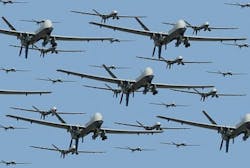Officials of the U.S. Defense Advanced Research Projects Agency (DARPA) in Arlington, Va., released a formal solicitation Friday (DARPA-BAA-14-33) for the Collaborative Operations in Denied Environment (CODE) program to enable UAVs to work together in teams and take advantage of the relative strengths of each participating unmanned aircraft.
The CODE program is to expand the mission capabilities of existing UAVs through increased autonomy and inter-platform collaboration. Collaborative autonomy has the potential to increase capabilities and reduce costs of today's UAVs by composing heterogeneous teams of UAVs that can capitalize on the capabilities of each unmanned aircraft without the need to duplicate or integrate capabilities into one UAV, DARPA officials say.
Although today's UAVs have proven themselves in a wide range of missions, most current UAVs are not well matched to the needs of future conflicts, DARPA officials say.
Compared to today, future conflicts will be much less permissive, very dynamic, confront U.S. and allied forces with more dangerous threats, and involve contested electromagnetic spectrum and relocatable targets, researchers say.
In these future conflicts UAVs could use collaboration algorithms to help each other with tasks like geo-locating targets with long-distance sensors, as well as guiding less-capable UAVs to within their sensor ranges.
Collaboration algorithms also could help UAVs work together to provide multi-modal sensors and diverse observation angles to improve target identification, transmit important information through the network, provide navigational aide to low-tech or damaged UAVs, and protect each other by overwhelming defenses.
Goals of the CODE program are to develop and demonstrate the value of collaborative UAV autonomy in tactical situations; rapidly bring that capability to the warfighter; develop ways to expand the range of collaborative UAV missions; and help researchers contribute to collaborative autonomy technologies.
DARPA researchers primarily are interested in four areas. First, they want to develop autonomy for the subsystems, equipment, and flight trajectories of UAVs working alone under routine and abnormal conditions.
Second, DARPA researchers want to develop interfaces to enable mission commanders to maintain situational awareness, dynamically define mission objectives and problems, monitor progress, and provide important inputs as necessary to several UAVs simultaneously.
Then researchers want to develop UAV team-level autonomy, including developing and maintaining a common representation of the operating environment to help formulate collaborative action plans that make the most of the strengths of each participating UAV.
Lastly, DARPA wants to develop an open architecture for UAV collaboration to help commanders maintain situational awareness and control of the UAVs in electronic jamming, poor communications, bad weather, and other adverse conditions. DARPA briefed industry on CODE program details earlier this month.
Related: Flexible & integrated unmanned command & control
The program will proceed in three phases. The first phase focuses on system analysis, architecture, design, and critical technologies. The first phase also has two tracks, one for system integrators and the other for technology developers.
The second phase involves detailed design of their CODE system and in-flight demonstrations. The third phase will develop and demonstrate full mission capability during three series of flight tests.
The first phase starts later this year, extends through early 2016, and will share $14.3 million among participating contractors. The second phase runs from early 2017 to mid-2017, and will share $15 million among contractors. The third phase runs from mid-2017 through the end of 2018 and will share $25 million among participating contractors.
Companies interested should submit abstracts no later than 2 Ma 2014, and full proposals by 10 June 2014. Email questions or concerns to DARPA at [email protected]. The DARPA Code program manager is Jean-Charles Lede.
More information is online at https://www.fbo.gov/spg/ODA/DARPA/CMO/DARPA-BAA-14-33/listing.html.

